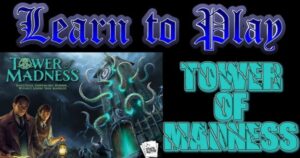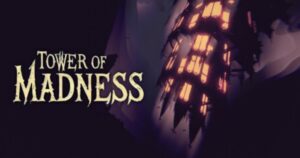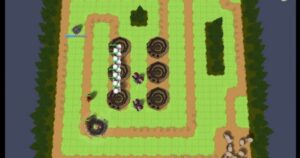Tower of Madness Review – Not quite what I anticipated, yet also a bit more.
Upon my initial encounter with Tower of Madness, a merging of the Cthulhu Mythos and the traditional game Kerplunk, I believed it to be merely a novelty.
After playing the game, I can confidently say it exceeds expectations. A genuine competition exists.
Disclaimer: Certain hyperlinks in this article are affiliate hyperlinks. By utilizing these links, it doesn’t incur any additional costs for you and it contributes to the backing of this blog and podcast. I receive compensation for eligible purchases made through my Amazon Affiliate links. I received a review copy of Tower of Madness from Smirk & Dagger, with no additional compensation given.
Contents
What comes with the board game Tower of Madness?

Curt Covert created and released it through his company Smirk & Dagger Games. The art showcased is by EJ Dela Cruz, Jen Santos, and Brian Valenza. The publication date was in 2018.
To get a sneak peek at the contents of this game, it’s best to check out my Tower of Madness Unboxing Video. In my opinion, it is one of our most entertaining videos, particularly the segment about sticky dice.
For individuals who have not viewed the video:

You discover a shiny, attractive rulebook inside the box. There are just seven pages of regulations present, yet there is a substantial amount of text. Despite the abundant examples and images, it seems overwhelming like a solid block of text. There are several examples available, and although the rules are mostly based on exceptions, they are generally easy to understand. We found ourselves checking the rules frequently during the initial two or three games. Adding a brief overview on the back of the rulebook or a separate page, which displays the various marble colors and the Unnatural Influence regulations, would be a valuable inclusion. I was disappointed to find that the rulebook in my game copy was tucked into the insert and very badly bent.
Inside the container, there is also a sack filled with green tentacles. I was particularly intrigued by the fact that nearly all production images of the game have been altered to hide the tentacles’ ends from protruding out of the tower. One side is sleek and shaped while the other is simply a twig colored green. Once the tower is constructed, you can observe both ends protruding in all directions. I find it a bit funny that they went to the trouble to remove the sticks from the pictures, but I don’t see it as an issue. I expect the tentacles, which are solid but slightly flexible plastic, to be durable and not easily breakable.

Following that comes the tower and its peak. This part is the standout moment of the game. The quality is excellent, thick and well crafted with beautiful artwork. The openings for the tentacles are color coded and visible easily. I didn’t notice at first when I opened the game, but the tower is actually magnetic, which is the coolest part. It can be quickly folded for storage and easily assembled in just a second. The rooftop is slightly more intricate and also magnetic. At first, I struggled with it, but now that I understand how it should be done, setting it up is also quick and easy.
The base is located beneath the tower. This is a large piece of black plastic. The tower fits perfectly. The sculpture is thought-provoking. There is a place for the green marbles to be placed once they are removed. There is nothing to criticize in this situation.
There is a bag with different counters and tokens as well. Seeing that these were already punched beforehand was pretty neat.
Speeding up the process of getting this game onto the table. The tokens are thick and pleasant. Player boards are made of identical cardboard and are pre-punched. These come with different indentations and ridges designed for keeping marbles in place. The package also contains a sack of marbles. All of these marbles are in the cat’s eye design, available in white, blue, red, green, and yellow. There are numerous red, white, and blue items, while there are only three green items and one yellow item.
Cards indicating locations were discovered beneath the marbles. These cards are square and feature captivating artwork. The text and icons on the cards are big, clear, and easily readable from a distance on the table. Next, there is an additional deck of cards. Character cards and spell cards are included in this package. The spell cards are remarkable due to their dual nature – one side being rational and the other irrational. The quality of the card is excellent.

At last, we have reached the adhesive dice. Affirmative, adhesive. Some mysterious substance had glued the dice together in the Tower of Madness game that I purchased. They easily separated but were clearly covered in a substance. Something adhesive that allowed me to lift a dice by pressing my finger against it. This is gross, and it always has been. After I voiced my concerns on the internet, Curt from Smirk & Dagger reached out to me and acknowledged that it was a recognized problem with the manufacturing process. He recommended cleaning the dice with soap and warm water. Getting these dice clean required a significant amount of soap, warm water, and soaking.
I encountered an additional production problem while putting together my tower for the first time. One Tentacle was absent from my Tower of Madness copy. I checked three times, concerned that I lost it while unpacking, but I only found a green tentacle missing. Smirk & Dagger sent me a replacement, which I appreciated, but I was still disappointed.
In my opinion, Smirk & Dagger should have a conversation with their manufacturer. A rulebook that is bent can be frustrating. The issue with the gummed-up dice is quite repulsive. Furthermore, the fact that I didn’t have a full game was truly disheartening. I was already disillusioned with the game before I even started playing it.
Tower of Madness demonstrates that it is not simply a Kerplunk with a new theme.
Before starting a game of Tower of Madness, the initial step is preparing the tower. This is not enjoyable. In contrast to Kerplunk, tentacles cannot be placed randomly; certain holes must be filled on each side of the tower, which is easier said than done. It took me a long time the first few times, but eventually I figured out to view the tower from the top or bottom to make it easier. However, it still takes a while.
After assembling the tower, invite three to five players to choose an investigator card and get a player board each. There are beginner detectives who are all the same or experienced ones who each possess a unique special skill. If you’re gaming with veterans, stick to the advanced levels. A deck of location cards is created with a quantity of cards equal to the number of players. The clock tower’s positioning is at the highest point.
During their turn, the player will roll the dice, which they hope are clean and not sticky. Players are attempting to roll five custom dice to obtain one gate (1), one heart (2) and one mind (3). Every turn, players are required to lock at least one die on their individual player board. There are slots for the entrance, soul and intellect, as well as two additional slots for exploration dice. The only thing of importance on the discovery dice is the number they display. The Yellow Sign (4), Elder Oak (5), and Elder Sign (6) symbols are present on the dice to activate investigator abilities or location effects. Players can keep rolling and re-rolling dice, choosing to lock at least one die each turn until they are unable to place any more dice.
Achieving a gate, heart, and mind signifies success in the investigation for a character. Their discovery dice are added together to determine their investigation score. This score is what they will have for the round. If they are unsuccessful, they must remove one tentacle from the tower. Once this task is completed, the following investigator takes over. At the conclusion of a round, the player with the highest investigation score acquires the location card, which holds point value for the game’s conclusion.
The game goes on until all the spots are checked or three green DOOM marbles drop from the tower.
There is a possibility of marbles dropping from the tower while removing the tentacles. This isn’t necessarily negative, in fact, at the beginning of the game you desire for marbles to drop on your turn. The function of each marble is determined by its color.
Green marbles are terrible. If three green marbles are removed, everyone in the group loses, unless the person who made the last one fall is crazy. In that situation, the crazy individual emerges victorious!
Discovery marbles, known as Blue Marbles, have a value of three points in the game’s final tally.
White Marbles are enchanted marbles that provide spell cards. These cards allow you to bend the rules and behave differently based on whether your investigator is in a state of sanity or insanity.
Insanity is symbolized by red marbles. If a player accumulates four red marbles, they go crazy. They currently utilize the crazy aspects of the magic cards, and during their round instead of rolling the dice, they simply pull tentacles and aim to finish the game by releasing green doom marbles.
Different special rules are present depending on the area under investigation, individual powers of the investigator, and the other symbols on the dice. One important point is that if a player rolls two Elder Oaks (5s), they can acquire an Unnatural Influence token to use for actions like rerolling dice or blocking a spell from another player.
If players reach the end of the location deck, the sane investigator with the highest score will be the winner.
My general impression of the board game Tower of Madness by Smirk & Dagger:
I felt a sense of relief when I carefully studied the rules of Tower of Madness and discovered it was a substantial game. It’s more than just removing tentacles and tallying marbles. There is a strategic push-your-luck dice game concealed within the flashy tower. A game with dice that is surprisingly enjoyable and full of suspense. The dice mechanism in Tower of Madness is so clever that I would go as far as to say it can stand alone.
The problem is that by doing well in the push your luck dice game you don’t get to do the thing that is supposed to be so neat about Tower of Madness. When you sit down to play this game you expect to be pulling all kinds of tentacles and dreading what comes out of the bottom of the tower. Instead, if you are playing well, you just roll dice, and pass them on and hope someone doesn’t roll better than you. When someone fails at that part of the game, they get the fun of pulling things from the tower.
Not only is pulling things from the tower more fun than just rolling dice and getting some points, it’s also a great way to get points on its own. The majority of the marbles in the tower are actually good. Yes, there are quite a few madness marbles in there but there are a significant number of spells that let you pass them to other players or upgrade them from insanity to discovery points. The big threat of pulling from the tower are the green Doom marbles, which seem to come out quickly once things get moving.
Speaking of things getting moving, this is my other issue with Tower of Madness. You can’t play cautiously. If you play this like Kerplunk only taking tentacles from the very top layer and maybe a few early in the game from the bottom, and you try your best not to have anything fall, you are actually playing wrong. For one, as noted above, most of the marbles are actually good, and second I find when you play this way that when marbles do fall you get a ton of them at once. Even when playing less cautiously it seems that you never get a couple of marbles dropping, it’s always a deluge of marbles.
After multiple plays, I make sure to inform players about this. I instruct them to gather tentacles from various locations. I inform individuals that they desire marbles to drop. Additionally, I arrange the marbles more strategically by thoroughly shaking the tower before starting and occasionally only inserting half of the tentacles, followed by marbles and then filling the remaining space. This improvement has enhanced the gameplay experience, although the issue of this aspect conflicting with the primary dice rolling mechanic remains.
My experience with this game has been quite varied. I noticed that many gamers like the dice mechanic and collecting investigator cards, but they are too hesitant to pull from the tower. Non-gamers struggle to understand the push your luck element in the dice game, enjoying pulling from the tower but seldom utilizing their spell cards effectively, resulting in few wins. My best results have come from a combination of gamers and non-gamers, balancing each other out with some focusing on the location card points while others take risks with the tower.
If your goal in Tower of Madness is to win, you’ll overlook the enjoyment of the tower mechanic. If pulling from the tower isn’t negative, why restrict it to occurring only after failing the initial game step? Feeling disappointed when you achieve a double six discovery score is common, even though it should be a moment of triumph.
exceeds my expectations with its level of gameplay, despite my initial skepticism about its complexity.
I have encountered individuals who adore it. There are certainly individuals who will find pleasure in playing this game. I simply wasn’t part of that group.
Ultimately, I desired either a light-hearted game with humor and take-that moments, or a more serious game with consequences for failing in the push-your-luck mechanic. Tower of Madness didn’t impress me, it fell short of expectations.




Post Comment